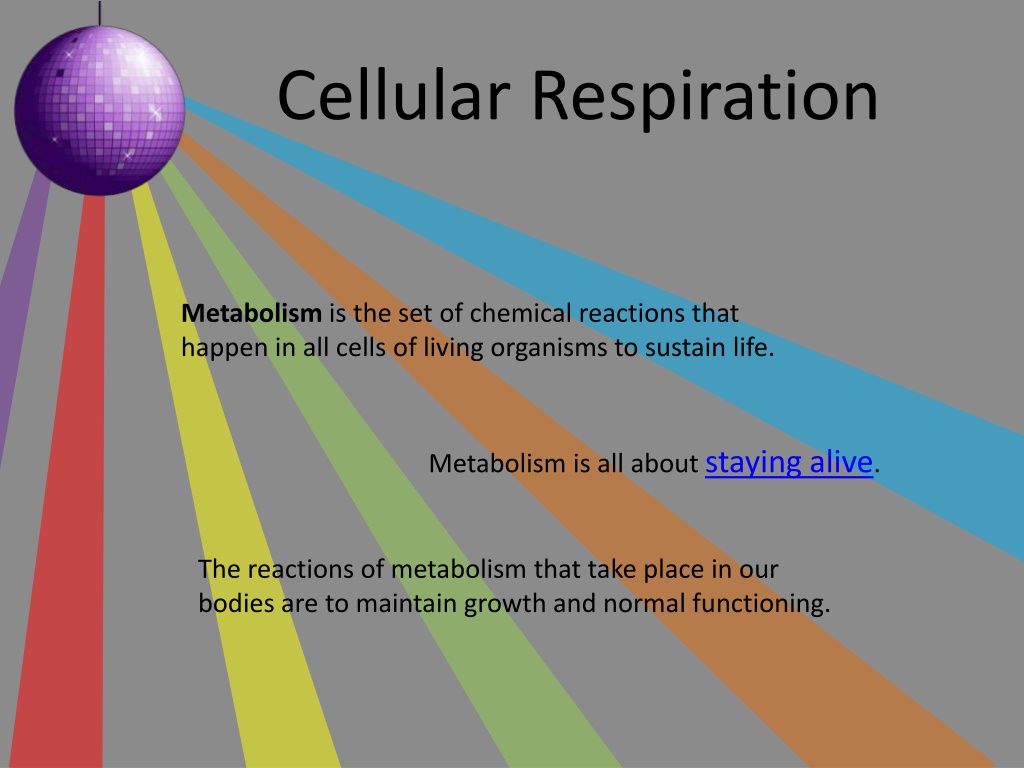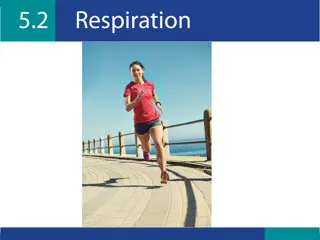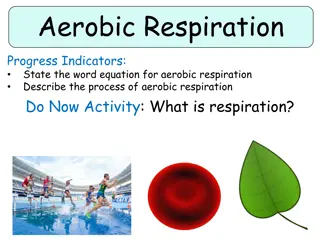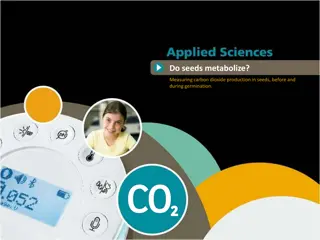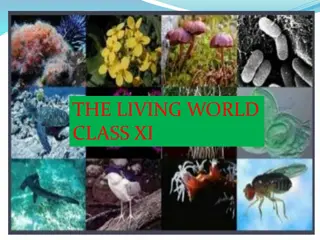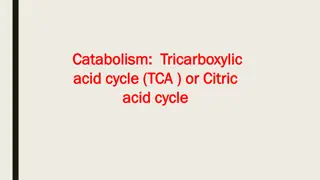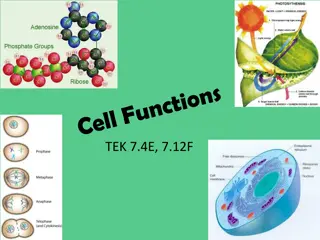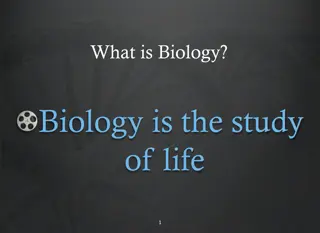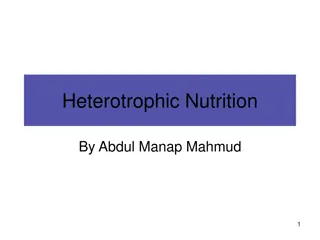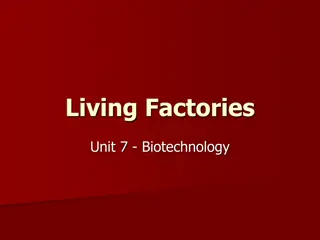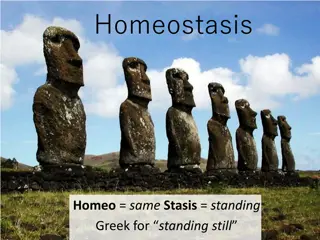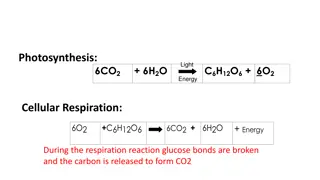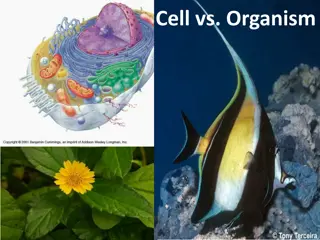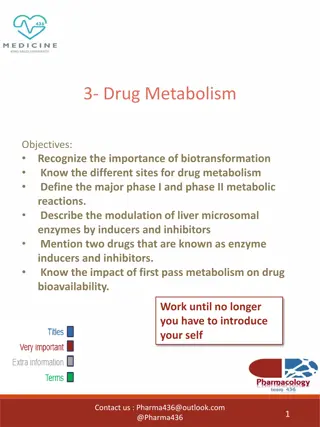Understanding Cellular Respiration and Metabolism in Living Organisms
Cellular respiration is a vital process in all living cells, producing energy through chemical reactions. Metabolism, consisting of anabolism and catabolism, maintains growth and function. ATP plays a central role as energy currency in cells. Through stages like glycolysis and the Krebs cycle, cellular respiration breaks down food molecules to generate ATP. This process contrasts with photosynthesis, where plants create glucose using sunlight. The breakdown of food in our digestive system provides essential nutrients for cellular processes.
Download Presentation

Please find below an Image/Link to download the presentation.
The content on the website is provided AS IS for your information and personal use only. It may not be sold, licensed, or shared on other websites without obtaining consent from the author. Download presentation by click this link. If you encounter any issues during the download, it is possible that the publisher has removed the file from their server.
E N D
Presentation Transcript
Cellular Respiration Metabolism is the set of chemical reactions that happen in all cells of living organisms to sustain life. Metabolism is all about staying alive. The reactions of metabolism that take place in our bodies are to maintain growth and normal functioning.
There are two parts to metabolism: Anabolism Catabolism Anabolism derives from the Greek words ana for upward and ballein for to throw. Catabolism derives from the Greek words kata for downward and ballein. Anabolism is the building up of molecules needed in our body made from nutrients in our food. not this Catabolism is the breakdown of molecules to obtain energy. An example of anabolism is photosynthesis. Plants and other photosynthetic organisms build glucose molecules for energy. An example of catabolism is cellular respiration, the breakdown of food into energy.
Cellular Energy Cells, like all living things, need energy to operate. Your calculator uses batteries for energy, but our cells don t need batteries. In fact, our cells create their own energy in the form of molecules called adenosine triphosphate or ATP for short. ATP is a high energy molecule and acts like cellular currency. You must spend (use up) ATP to power most of the reactions taking place in cells. adenosine triphosphate ATP When the third phosphate group is broken off of ATP, a burst of energy is released that the cell harnesses to do work. A P P P three phosphate groups R adenosine = adenine + ribose ATP powers all living organisms in every kingdom: animalia fungi monera plantae protista
Cellular Respiration The process in which cells make ATP is known as cellular respiration. It is the breakdown of chemical bonds in food molecules for energy. (catabolism) Once food has been broken down cellular respiration occurs in three stages: 1. Glycolysis 2. Krebs Cycle 3. Electron Transport Chain The conversion of glucose to pyruvate. The conversion of pyruvate into ATP and charging of NADH. The passing of excited electrons to generate ATP.
The Cellular Respiration reaction: C6H12O6 + 6 O2 6 CO2 + 6 H2O + ATP 6 Carbon dioxide molecules 1 Sugar (glucose) 6 Oxygen molecules 6 Water molecules Cellular Respiration is essentially the opposite of Photosynthesis. (Catabolic reaction: breakdown of molecules we need to live) (Anabolic reaction: building of molecules we need to live) The Photosynthesis reaction: 6 CO2 + 12 H2O + sunlight 6 Carbon dioxide molecules C6H12O6 + 6 O2 1 Sugar (glucose) 12 Water molecules 6 Oxygen molecules
The Breakdown of Food The breakdown of food occurs in our digestive system. Our digestive system includes our mouth, esophagus, stomach, liver, pancreas, gallbladder and intestines. When we digest our food, it is broken down into its smallest, basic units. Complex Food Molecules Basic Units Amino acids are the building blocks our cells use to make proteins, an example of anabolism. Proteins Amino Acids Fats (lipids) Fatty acids and glycerol Carbohydrates (polysaccharides) Glucose (a simple sugar) Cells turn fatty acids into many things like the enzymes used in glycolysis. Glucose is turned into ATP. 1 glucose molecule makes about 38 ATP molecules.
Stage 1. Glycolysis Glycolysis starts with glucose and takes place in the cytoplasm. Glycolysis is an anaerobic reaction this means it does not need oxygen to occur. Glycolysis splits glucose, a 6 carbon ring, in half. This makes 2 molecules of pyruvate, a 3 carbon molecule. In order to split the glucose molecule, glycolysis needs to spend some energy. 2 ATPs are used to break glucose in half into 2 pyruvate molecules. Each pyruvate molecule makes 2 ATPs and 1 NADH. This is a total of 4 ATPs made and with 2 ATPs spent the net gain of glycolysis is 2 ATP. ( 2 + 4 = 2) Glycolysis Video Glycolysis Video
Pyruvate O2 O2 If oxygen is present, pyruvate undergoes the Krebs Cycle. If oxygen is not present, pyruvate undergoes Fermentation. With oxygen present, pyruvate can turn into Acetyl-CoA which is needed in the Krebs Cycle. Acetyl-CoA (Acetyl-Coenzyme A) is a crossroads compound because when all three food molecules are broken down into their basic units some will become Acetyl-CoA and start the Krebs Cycle. Stage 2. Krebs Cycle The Krebs Cycle is also called, the Citric Acid Cycle because citric acid is involved. Citric acid is also found in citrus fruits! The Krebs Cycle is an aerobic reaction, this means it requires oxygen to occur. Bro fist! The Krebs cycle was discovered in the 1930s by Albert Szent-Gy rgyi and Hans Adolf Krebs.
Mitochondrial Endosymbiosis The Krebs Cycle takes place in an organelle called the mitochondria which is nicknamed the power house of the cell because it provides the energy the cell needs to live. Remember ATP powers all eukaryotic cells. This means there are mitochondria in plants undergoing cellular respiration. A long time ago, our cells were once ancient eukaryotic cells that enveloped a prokaryote. Eventually, the prokaryote became a part of the cell and dependent upon it for life which in turn gave our cell the ability to generate ATP. This theory about how mitochondria got inside eukaryotic cells is the endosymbiotic theory. All your mitochondria came from your mother. Thank your mom for all the mitochondria!
Stage 2. The Krebs Cycle The Krebs Cycle involves the breakdown of pyruvate and occurs in the mitochondrial matrix. Inner Membrane Outer Membrane Stage 3 the Electron Transport Chain will take place in the inner mitochondrial membrane. Intermembrane Space Mitochondrial Matrix (innermost space) The breakdown of pyruvate involves many enzymes breaking off carbons. These carbons bond with oxygen making the byproduct carbon dioxide that we breathe out. As pyruvate is broken down into small packets of energy , that are released in the form of excited electrons ( ). e- This energy is used to make ATP and charge up NADH and FADH2 molecules. Krebs Cycle Video Krebs Cycle Video
Stage 3. The Electron Transport Chain During the stages of the Krebs Cycle the high energy molecule ATP is generated but so are energy carrier molecules NADH and FADH2. NAD+ can hold excited electrons made during the Krebs Cycle, becoming NADH. e- nicotinamide adenine dinucleotide NAD+ FAD+ is another high energy molecule made during the Krebs Cycle that carries 2 excited electrons becoming FADH2. flavin adenine dinucleotide N A P P R R FAD+ N Eventually, both pass the excited electrons they re carrying to power up protein complexes in the mitochondria membrane. Once empty handed, they revert back to NAD+ and FAD+ and undergo the Krebs Cycle again. e- P P F R Both energy carrier molecules are very complex, these diagrams are simplifications.
Stage 3. The Electron Transport Chain The protein complexes in the mitochondrial membrane sit next to each other like links in a chain. zz z z z z e- H+ When an excited electron is passed to the protein complexes from either a NADH or FADH2 energy carrier, the electron is passed from one protein complex to another down the chain powering up each one as it goes. H+ e- H+ H+ When powered up, the protein complexes pull a proton (H+) across the inner mitochondrial membrane into the intermembrane space of the mitochondria. Once the concentration of protons is high enough in the intermembrane space, a proton will travel down its concentration gradient crossing the inner mitochondrial membrane. This crossing powers an ATPase protein complex that generates ATP.
Stage 3. The Electron Transport Chain At the end of the chain, the excited electron is not so excited as it lost a lot of energy being passed along. The electron joins up with oxygen and protons inside the mitochondrial matrix to form a molecule of water. O O H+ H+ e- This is why we breath in oxygen. We need oxygen to accept the electrons at the end of the electron transport chain. Without oxygen to accept these electrons, the Krebs cycle would stop and no more ATP would be made. Remember the Electron Transport Chain needs oxygen so it is aerobic (with oxygen) respiration.
Pyruvate Fermentation O2 Fermentation After glycolysis if oxygen is not present, pyruvate will undergo fermentation. Fermentation is also known as anaerobic (without oxygen) respiration. Fermentation is a very quick processes with a net gain of 2 ATP. So why undergo fermentation? The Krebs Cycle makes ~38 ATP per glucose molecule and Fermentation only makes 2 ATP per glucose molecule! Fermentation is a quick way to make ATP when you really need it. For example, when you exercise the oxygen available for your cells is used up in the Krebs Cycle making ATP. That s why we run out of breathe during exercise and we take deep breaths to try and replenish oxygen to our cells. When not enough oxygen is reaching our cells they will undergo fermentation to make some quick ATP to keep us moving.
Cellular Respiration Summary Glycolysis Glycolysis 2 ATP 2 ATP oxygen no oxygen + 2 ATP 4 ATP Krebs Cycle ETC + 36 ATP 38 ATP Fermentation Occurs in cytoplasm and mitochondria. All occurs in cytoplasm. Carbon dioxide is a byproduct produced during the Krebs Cycle. Food molecules are broken down into glucose. Water is a byproduct made during the electron transport chain. C6H12O6 + 6 O2 6 CO2 + 6 H2O + 38 ATP Oxygen is needed to accept the electrons at the end of the electron transport chain.
Cellular Respiration Review Metabolism is the set of chemical reactions that happen in all cells of living organisms to sustain life. We humans, undergo the catabolic metabolism reaction known as cellular respiration wherein the food we eat is broken down and converted into energy for our cells. Cellular respiration has 3 steps after our food has been broken down into basic units: 1. Glycolysis turns glucose into pyruvate 2. Krebs Cycle generates ATP molecules and charged energy carrier molecules 3. Electron Transport Chain excited electrons generate ATP 1 glucose can make ~38 ATP molecules. Without oxygen, pyruvate cannot enter the Krebs Cycle and instead fermentation occurs.
